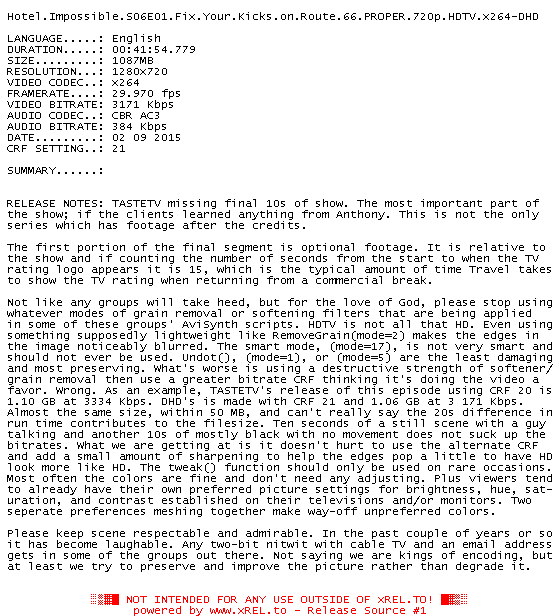
Hotel.Impossible.S06E01.Fix.Your.Kicks.on.Route.66.PROPER.720p.HDTV.x264-DHD
LANGUAGE.....: English
DURATION.....: 00:41:54.779
SIZE.........: 1087MB
RESOLUTION...: 1280x720
VIDEO CODEC..: x264
FRAMERATE....: 29.970 fps
VIDEO BITRATE: 3171 Kbps
AUDIO CODEC..: CBR AC3
AUDIO BITRATE: 384 Kbps
DATE.........: 02 09 2015
CRF SETTING..: 21
SUMMARY......:
RELEASE NOTES: TASTETV missing final 10s of show. The most important part of
the show; if the clients learned anything from Anthony. This is not the only
series which has footage after the credits.
The first portion of the final segment is optional footage. It is relative to
the show and if counting the number of seconds from the start to when the TV
rating logo appears it is 15, which is the typical amount of time Travel takes
to show the TV rating when returning from a commercial break.
Not like any groups will take heed, but for the love of God, please stop using
whatever modes of grain removal or softening filters that are being applied
in some of these groups' AviSynth scripts. HDTV is not all that HD. Even using
something supposedly lightweight like RemoveGrain(mode=2) makes the edges in
the image noticeably blurred. The smart mode, (mode=17), is not very smart and
should not ever be used. Undot(), (mode=1), or (mode=5) are the least damaging
and most preserving. What's worse is using a destructive strength of softener/
grain removal then use a greater bitrate CRF thinking it's doing the video a
favor. Wrong. As an example, TASTETV's release of this episode using CRF 20 is
1.10 GB at 3334 Kbps. DHD's is made with CRF 21 and 1.06 GB at 3 171 Kbps.
Almost the same size, within 50 MB, and can't really say the 20s difference in
run time contributes to the filesize. Ten seconds of a still scene with a guy
talking and another 10s of mostly black with no movement does not suck up the
bitrates. What we are getting at is it doesn't hurt to use the alternate CRF
and add a small amount of sharpening to help the edges pop a little to have HD
look more like HD. The tweak() function should only be used on rare occasions.
Most often the colors are fine and don't need any adjusting. Plus viewers tend
to already have their own preferred picture settings for brightness, hue, sat-
uration, and contrast established on their televisions and/or monitors. Two
seperate preferences meshing together make way-off unpreferred colors.
Please keep scene respectable and admirable. In the past couple of years or so
it has become laughable. Any two-bit nitwit with cable TV and an email address
gets in some of the groups out there. Not saying we are kings of encoding, but
at least we try to preserve and improve the picture rather than degrade it.

![]() Registrierte Benutzer können Text-, Hintergrund- und ANSI-Art-Farbe individuell anpassen!
Registrierte Benutzer können Text-, Hintergrund- und ANSI-Art-Farbe individuell anpassen!